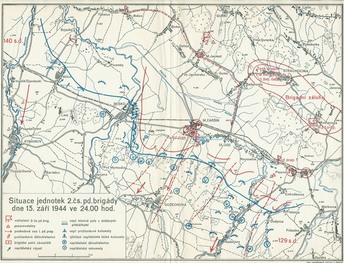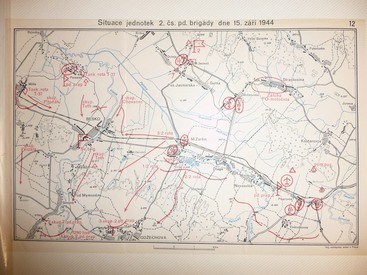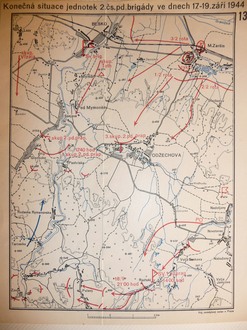PASTWISKA

Lieutenant František Geisler was released from war service in June 1944 and for him it was the end of the War. But when he heard about the 2nd Czechoslovak Parachute Brigade being formed for service on the Eastern Front he volunteered for this unit so that he could participate in the liberation of their homeland.
On the 15th July 1944 he took the train with the other officers of the brigade to Greenock in Scotland where he boarded a sea convoy on the 18th July 1944 travelling via Gibraltar to Port Said then by land and sea through Damascus, Basra and Baku. Upon arrival in the USSR he got together with other officers at Sadagura which housed the reserve corps of 1.ČSAZ -
The body had gone to the kitchen for the soldiers enjoyment where the soldier assigned to Lt. Geisler could boast of the trophy. The deer had been hit in the head, just between the left eye and nose. So the trophy head was tied to a vehicle with the comment that it would be stuffed later.
Lt. Geisler was assigned to the 2nd Czechoslovak Parachute Brigade second Battalion under command of Major Voves. Also to this battalion were included other officers from England, Renčí, Vrzala, Pavéka and Flax. He was assigned as a platoon commander of a platoon made up of mostly young and skilled fighters, Slovaks and Ruthenians. Geisler, however, quickly gained the favour and respect. The platoon armed with light automatic machine guns was in reserve in the assembly battalion as a special squad of soldiers armed only with machine guns and grenades. Their task was for combat reconnaissance duties, various attacks or bypasses or to break the enemy position using appropriate tactics. Lieutenant Geisler was a specialist in these skills serving before in such "action" units.
 The first action of the Geisler unit was night patrol southwest of the village Zarszyn on the first day of deployment, 12th September 1944. The village was largely destroyed and constantly shelled by mortars. The village was located on a railway line which was raised on an embankment. This mound served as cover for soldiers prior to moving into the village so it gave good protection to the platoon before moving forward. After reaching the edge of the village the platoon found in the ruins of a house a kind old lady, an inhabitant of the village she was able to show them the best way of getting through the village to join the front line of the battalion. In the basement of the local brewery there was located the self propelled artillery company of the brigade and they were very pleased to have the machine gun platoon join them. The commander of the company informed Lt. Geisler about the current situation and together they went on a reconnaissance. The village was located on the front line where also there were several units of the Parachute Brigade. Forward movement was really only possible at night and Lt. Geisler was also aware that the whole area was mined. Movement forward would only be possible with the help of Soviet engineers who had to remove obstacles and mines in the direction of the advance. After a briefing on the situation the platoon waited in the darkness and around 2230 the action began. Lt. Geisler was arguing with four Soviet sappers who had been checking the ground and acting carelessly earlier before it was dark when in the night the full moon was shining.
The first action of the Geisler unit was night patrol southwest of the village Zarszyn on the first day of deployment, 12th September 1944. The village was largely destroyed and constantly shelled by mortars. The village was located on a railway line which was raised on an embankment. This mound served as cover for soldiers prior to moving into the village so it gave good protection to the platoon before moving forward. After reaching the edge of the village the platoon found in the ruins of a house a kind old lady, an inhabitant of the village she was able to show them the best way of getting through the village to join the front line of the battalion. In the basement of the local brewery there was located the self propelled artillery company of the brigade and they were very pleased to have the machine gun platoon join them. The commander of the company informed Lt. Geisler about the current situation and together they went on a reconnaissance. The village was located on the front line where also there were several units of the Parachute Brigade. Forward movement was really only possible at night and Lt. Geisler was also aware that the whole area was mined. Movement forward would only be possible with the help of Soviet engineers who had to remove obstacles and mines in the direction of the advance. After a briefing on the situation the platoon waited in the darkness and around 2230 the action began. Lt. Geisler was arguing with four Soviet sappers who had been checking the ground and acting carelessly earlier before it was dark when in the night the full moon was shining.
Then the engineers removed the obstacles and the first section from the light machine gun platoon moved forward and entered the corn field but before any progress could be made with another section there was firing. Further advance and work on the obstacles was halted when the Germans launched a mortar attack. One Russian sergeant lost his leg above the knee and died. The whole light machine gun platoon rapidly fanned out through the minefield to eliminate the obstacles. One of the platoon stepped onto a mine which tore off his leg at the calf whilst the rest of the platoon got onto the forest slope. The darkness in the forest hid the soldiers and the mortar fire stopped and slowly they moved forward following the slope below the forest. The platoon spread out and moved into the forest in complete darkness, there suddenly unleashed a wild shootout on both sides. Lt. Geisler immediately commanded a section forward throwing grenades in front of themselves. Soon they discovered the foxholes of the German position and there they fought man to man. One of section hauled out his fighting knife and jumped on the Germans shouting "Drop dead, you beggar!”The German soldier had been sleeping because he had unbuttoned tunic and was barefoot. Lt Geisler regrouped the platoon in the newly taken positions, covering its flanks with machine guns. He himself had pulled into a foxhole one of his own wounded soldiers and other soldiers were slowly emerging from a hot firefight but the platoon had several wounded. Lt. Geisler sent the message to the Headquarters of the Battalion that the position was taken and around 0400 the platoon alternated in positions with another platoon from the battalion with the light machine gun platoon falling back. Lt Geisler came to report to Major Voves personally and his unit was praised for doing the almost impossible nocturnal advance and as a reward the platoon was given a day's rest in the rear lines. In the course of this combat most of Lt Geisler's soldiers survived.
 After the rest his platoon was then assigned to a company from the assault battalion under the command of Lieutenant Toth in the area of the village of Besko. But after the successful occupation of the enemy positions the previous day the Germans came back with a powerful counter-
After the rest his platoon was then assigned to a company from the assault battalion under the command of Lieutenant Toth in the area of the village of Besko. But after the successful occupation of the enemy positions the previous day the Germans came back with a powerful counter-
Battles in and around Pastwiska started the 17th September 1944 in the morning and Lt. Geisler's unit carried out several fighting reconnaissances. In one of them, Lt. Geisler again helped with the evacuation of the wounded, he took Sergeant Hrabovský back and moved him to safety. The next day the 18th September 18 about 15.00 the light machine gun platoon were again sent on a reconnaissance mission, the aim was the edge of the forest south of Pastwiska. The platoon headed towards the forest through exposed fields alongside the deep river valley at around 16.00. Already it seemed that unit would penetrate into the forest but suddenly there were shots from a machine gun and silently Lt. Geisler fell forward on his side, the bullet hit him between the left eye and nose. Other testimony (Private Frost) argues, however, that Lt. Geisler was first hit in the legs and began to call to Sergeant Major Rykšlsa and then was hit in the head. The unit came to a halt returning fire before they would have further losses but the overwhelming fire power of the Germans had them retreat. One of his soldiers sighed: "Boys, our leader who was not afraid is lost and it is difficult to go on without him."
After this day of fighting the 2nd Czechoslovak Parachute Brigade was transferred to the airport in Krosno in order to board planes to be flown south to assist in the Slovak National Uprising. However bad weather prevented the take off of the planes and the Brigade stayed put in Krosno. It was in this time that Lt. Geisler friend's, Vrzala and Flax returned to Pastwiska and on the 27th September the lieutenant's body was buried close by where he was killed.
Lieutenant Geisler was to have been posthumously decorated for his bravery but this never took place….
Literature:
Mastný, František; Chlapci od brigády, HSVO MNO 1945
Šáda M.,Krátky K.,Beránek J., Za svobodu Československa, sv.2, Naše vojsko, Praha 1961
RODÁK, J. Pozabudnuti hrdinovia, vojnové a povojnové príbehy. [s.l.] : ADIN, 2012. 136 s. ISBN 978-

©FG Solutions 2015
This site was last updated on
31/07/2015


